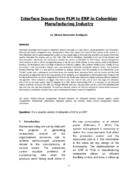Mostrar el registro sencillo del ítem
Interface Issues from PLM to ERP in Colombian Manufacturing Industry
| dc.contributor.advisor | Ospina Parra, Hector Fabio | |
| dc.creator | Bermudez, Stivens | |
| dc.date.accessioned | 2018-07-28T19:15:33Z | |
| dc.date.available | 2018-07-28T19:15:33Z | |
| dc.date.created | 2016 | |
| dc.identifier.uri | http://hdl.handle.net/20.500.12237/1096 | |
| dc.description | Las empresas colombianas han comenzado a implementar paquetes de software como una nueva forma de capturar información de costos de producción, datos financieros y de gestión del mercado, entre otros; estas herramientas apoyan el lanzamiento de su producto al mercado de una manera más eficiente mediante el uso de sistemas de gestión para rastrear el estado de los activos o la planificación del tiempo, y hay varios sistemas de información que permiten este proceso como CAD, CDM, PDM, ERM o Workflows. dependiendo del tamaño de la empresa y sus necesidades. Específicamente, la industria manufacturera ha mostrado una inclinación por la gestión del ciclo de vida del producto (PLM) porque se utiliza en todas las fases de gestión en el ciclo de vida del producto en cada punto de proceso (manufacturado, técnico y gerencial) y también ayuda a mantener seguimiento de los proveedores clave, los datos de retroalimentación de los clientes; ayuda a rastrear los datos del producto y el análisis comercial sobre la información cruzada estructurada (entre los niveles de la empresa). El Enterprise Resource Planning (ERP) también es utilizado por las empresas como software estratégico, con la posibilidad de ser implementado como un sistema "holístico" que es adecuado para alcanzar tres niveles, el nivel estratégico, el nivel operacional y el nivel de misión que ayudan la empresa para reducir el costo del proceso cruzado de la empresa, a nivel operativo o administrativo. Los programas como Microsoft Dynamics Axe se pueden integrar a un PLM para buscar la interfaz de datos en los procesos analíticos que están relacionados con la administración. Cuando las empresas son más grandes, necesitan cubrir nuevas áreas de datos, y para llegar a esta etapa, las compañías con un PLM como sistema principal, necesitan integrarse a un ERP. Antes de implementar ERP, es necesario usar herramientas que expongan los procesos sistemáticos de la manera correcta a través de diferentes vistas generales, porque puede haber un riesgo si la implementación no cuenta con la migración de datos correcta. La interfaz entre sistemas ayudará a la empresa a adquirir una mejor información transversal (en producción, niveles financieros y en marketing y gestión de recursos humanos). | spa |
| dc.description.abstract | Colombian companies have started to implement software packages as a new way to capture production cost information, financial and market management data, among others; these tools support the launch of their product to the market in a more efficiently way by using management systems to track asset status or time planning, and there are several information systems that allow this process such as CAD, CDM, PDM, ERM or Workflows, depending on the size of the company and their necessities. Specifically, the manufacture industry has shown an inclination for the Product Lifecycle Management (PLM) because is used in all the management phases in the life cycle of the product at every process point (manufactured, technical, and managerial) and it also helps to keep track of the key suppliers, the customers feedback data; it helps to trace the product´s data and business analytics over cross-structured information (among the company levels). The Enterprise Resource Planning (ERP) it is also used by companies as strategic software, with the possibility to be implemented as an “holistic” system that is adequate to reach three levels, the strategic level, operational level, and the mission level that help the business to reduce the cost of the cross process of the company, at an operational or administrative level. Programs like the Microsoft Dynamics Ax can be integrated to an PLM to look for the data interface in analytic processes that are related to management. When companies are bigger, they need to cover new areas of data, and to reach this stage, the companies with a PLM as the main system, need to integrate to an ERP. Before implementing ERP, it is necessary to use tools that expose systematic processes the right way through different overviews, because there can be a risk if the implementation does not have the right data migration. The interface between systems will help the company to acquire better transverse information (in production, financial levels, and in marketing and human resource management). | spa |
| dc.format.mimetype | application/pdf | |
| dc.subject | Gestión del ciclo de vida del producto | spa |
| dc.subject | Sistemas empresariales | spa |
| dc.title | Interface Issues from PLM to ERP in Colombian Manufacturing Industry | spa |
| dc.subject.subjectenglish | Product Lifecycle Management | spa |
| dc.subject.subjectenglish | Enterprise systems | spa |
| dc.rights.accessRights | info:eu-repo/semantics/openAccess | spa |
| dc.creator.degree | Ingeniero Industrial | spa |

